John Beugo, a Scottish engraver and printmaker, was born in Edinburgh on 7th May 1759 to Gavin Beugo, Preacher of the Gospel, and Elizabeth Pillans. His baptism took place in Edinburgh a few days after his birth, on 13th May.

John Beugo’s birth entry
Crown copyright, National Records of Scotland (NRS), Old Parish Register of births, Edinburgh, 685/1 page 69
His parents had married in Edinburgh 16 years earlier on 4th December 1743.

Gavin Beugo and Elizabeth Pillan’s marriage entry
Crown copyright, NRS, Old Parish Register of marriages, Edinburgh, 685/1 page 8
Engraving had become an established art form long before it reached Scotland. In Italy and Germany it was practised by the 15th century, reaching England by the end of the 16th century and not finding popularity in Scotland until the mid-17th century. In 1681, for example, the first edition of Murray of Glendook’s (modern-day Glendoick, Perthshire) folio ‘Acts of Parliament of Scotland’ was published containing a number of fine line engravings including the Arms of Scotland and portraits of Stuart monarchs.

An engraving from The Laws and Acts of Parliament compiled by Sir Thomas Murray of Glendoick, (David Lindsay, Edinburgh, 1681)
Source: NRS Library, GA 003.000
Richard Cooper, an English engraver, settled in Edinburgh and founded a school of engraving there where many plates depicting images of the royal family and nobility were produced. His son, also Richard, continued in this line of work.
In the 1780s, John Kay, a Scottish barber from Dalkeith, began to create etching caricatures of well-known social figures of the day, opening a small print shop in Parliament Close, Edinburgh, in 1785. Kay became so popular that he created a great number of miniature portraits and paintings. After his death, his etchings were collected into the book ‘A series of original portraits and caricature etchings by the late John Kay, with biographical sketches and illustrative anecdotes.’ Today, these provide us with a unique insight into Edinburgh and it’s inhabitants in the late 18th and early 19th centuries.
Around the time Kay was establishing himself as an artist, Beugo was also practising this art form. Etchings provided a keen source of income for an artist as copies of popular artworks could be quickly and cheaply reproduced and bought by the lower classes. Etchings were also a popular form of design in the header of bills and receipts and so seen by people in a variety of occupations.
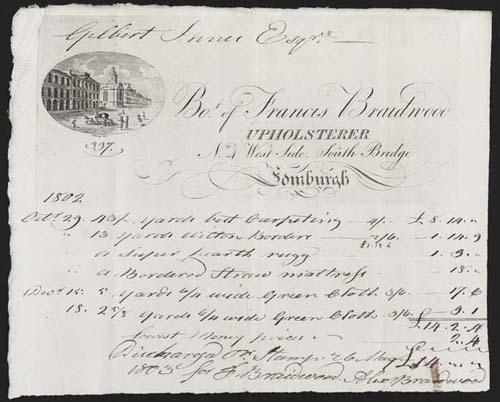
A receipt from Francis Braidwood’s workshop, 4 West Side, South Bridge, Edinburgh to Gilbert Innes of Stow, 26th May 1803. The engraving at the head of the receipt by John Beugo shows the South Bridge and Tron Kirk.
NRS, GD113/5/340/87
Robert Brydall, in his 1889 publication ‘Art in Scotland: Its Origin and Progress’, notes that Beugo ‘distinguished himself in the art both in line and stipple’ (page 206). The majority of his works were portraits (although he did execute a little work in landscape engraving), including the Earl of Denbigh; Dr William Cullen, chemist and physician, and Henry Home, Lord Kames, Scottish judge and author.
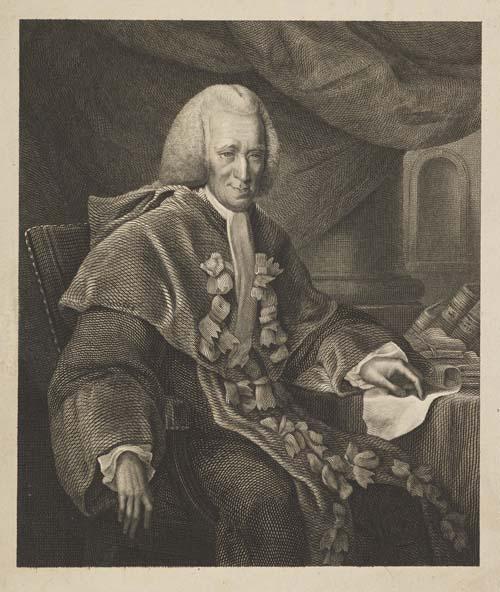
An engraving of Henry Home, Lord Kames, by John Beugo
Credit: The National Galleries of Scotland
Beugo was a good friend of the poet Robert Burns. Indeed, his portrait engravings of the bard are amongst his most celebrated works. An engraving by Beugo, after Nasmyth, features on the frontispiece of the first edition of Burns’ publication ‘Poems, Chiefly in the Scottish Dialect’, 1787. When Burns toured the Scottish Borders, West Central areas of Scotland and parts of the Highlands to promote the book, he took three dozen copies of Beugo’s engraving with him to hand out on the way.

A stipple engraving of Robert Burns by John Beugo, after Nasmyth
Credit: The National Galleries of Scotland
A copy of a letter written by Burns from his farm at Ellisland to Beugo is held by Orkney Archive (reference D1/15/6). In it Burns admits to being bored by the lack of entertainment where he was ‘at the very elbow of existence’ and that his neighbours ‘have as much an idea of a Rhinoceros as of a Poet.’ Burns was also interested in his friend’s personal life: ‘You do not tell me if you are going to be married. Depend upon it, if you do not make some damned foolish choice, it will be a very great improvement in the Dish of Life. I can speak from Experience: tho’ God knows my choice was as random as Blind-man’s buff.’
Beugo’s name appears in NRS' online catalogue in relation to a High Court case of December 1795. James Cunningham, a letter stamper and carrier in the General Post Office, Edinburgh, was indicted for the crime of theft, in particular for intercepting money sent by Mrs Elizabeth Beugo to her son John ‘Engraver in Edinburgh, then residing in Hamilton’ in the post. Mrs Beugo had sent five Bank of Scotland guinea notes through the General Post Office on 11th July of that year. In the days following, Cunningham opened the letter and the ‘said five guinea notes [were] feloniously abstracted by you, the said James Cunningham, and the money appropriated to your own use.’ A short time later, Cunningham became concerned that his crime would be discovered and replaced the money with a note by the Royal Bank of Scotland and altered the date of the letter to the 14th of July, resealed with wax and posted the letter, which was received by Beugo on 19th July. The case was eventually abandoned (NRS, JC26/1795/41).
At the time this case was heard, Beugo was admitted to the Royal Company of Archers. Originally formed in 1676 as a private archery club, they claimed the right to act as the sovereign’s personal bodyguard when King George IV visited Edinburgh in 1822. Today, they still undertake this ceremonial honour when the King visits Scotland.
The admission recorded that ‘At Edinburgh, the 26th day of Dec[embe]r One Thousand Seven Hundred and Ninety Five… The Council of the Royal Company of Archers, After tryal when by the Judges of the Company & their report, Have admitted and Reciev’d and hereby admit and Receive you John Beugo Engraver To be one of his Majesty’s Royal Company of Archers, GIVING and GRANTING to you, all the privileges and Immunities that are, or may be Competent, to any of the said Company.’
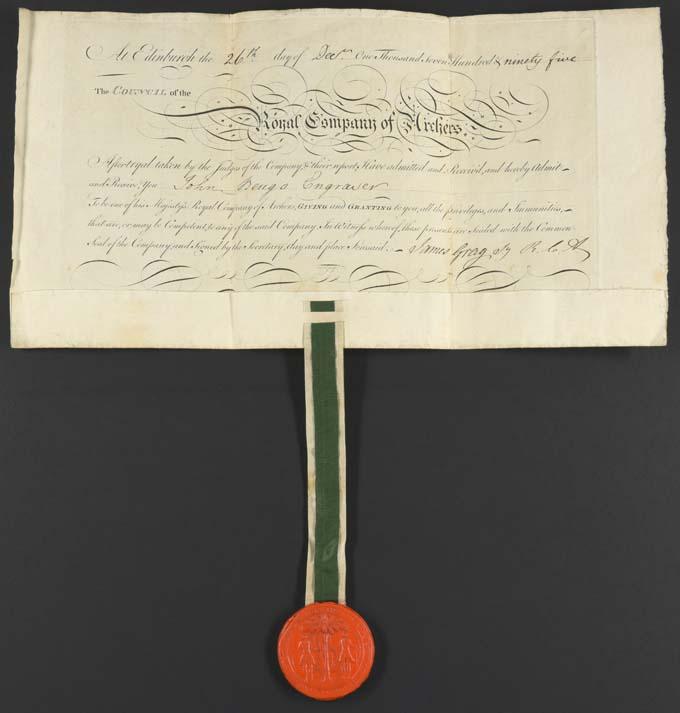
Act of Admission by the Royal Company of Archers in favour of John Beugo, engraver NRS, GD103/2/460.
Reproduced by kind permission of the Society of Antiquaries of Scotland.

The seal appended to Beugo’s act of admission. NRS, GD103/2/460.
Reproduced by kind permission of the Society of Antiquaries of Scotland.
As a member of the Royal Company of Archers, Beugo completed an engraving of Dr Nathaniel Spens, a medical professional and President of the Royal College of Physicians, Edinburgh, from 1794-1796. Elected to the Royal Company in 1750, he was a member for 65 years, and won multiple awards in competitions including the Edinburgh Arrow three times. Today, the Royal Company still compete for the Spens Medal, instituted in 1833 in his memory. In 1791 the Royal Company commissioned Sir Henry Raeburn to paint an portrait of Dr Spens and, in 1796, this was reproduced by Beugo.

John Beugo's engraving of Dr Nathaniel Spens, after Sir Henry Raeburn, 1796
Credit: The National Galleries of Scotland
As Beugo neared the end of his fourth decade, he married Elizabeth McDowall in Edinburgh on 4th January 1808.

John Beugo and Elizabeth McDowall’s wedding entry
Crown copyright, NRS, Old Parish Register of marriages, Edinburgh, 685/1 page 271
The couple had a daughter, Agnes, who was born in Edinburgh on 17th January 1810.

Agnes Beugo’s birth entry
Crown copyright, NRS, Old Parish Register of births, Edinburgh, 685/1 page 140
Seven months later, on 26th July 1810, Beugo was awarded a Burgess Ticket of Hamilton. This provided him with the right to work and trade in the Burgh free of charge with liberty ‘to Enjoy the whole priviledges & Immunities thereto belonging as amply in all respects as any Burgess does or can Enjoy who accepted thereof and gave his oath de fideli.’
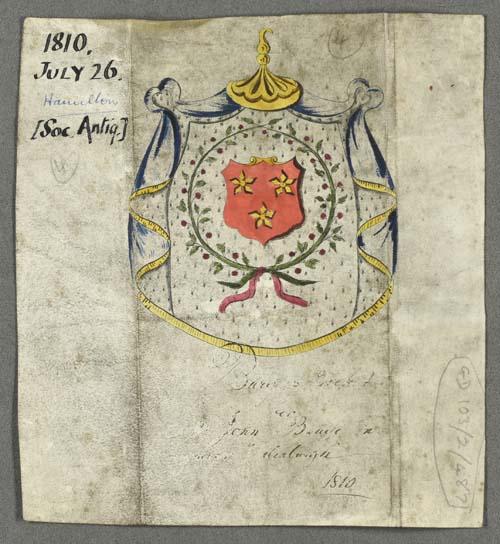
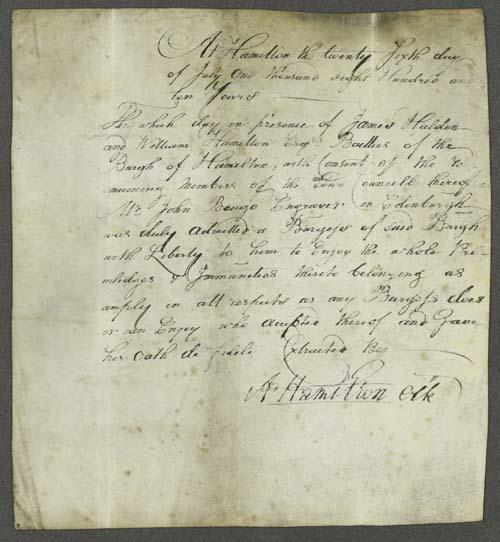
Burgess Ticket of Hamilton in favour of Mr. John Beugo, engraver in Edinburgh. NRS, GD103/2/487.
Reproduced by kind permission of the Society of Antiquaries of Scotland.
John Beugo died on 13th December 1841, followed by his wife eight years later in 1849. His headstone is in Greyfriars Churchyard in Edinburgh. His daughter Agnes and her husband John Scott are also commemorated on the stone.

John Beugo’s headstone
Credit: Public domain under the Creative Commons Attribution-Share Alike 4.0 International license. Photographer: Stephencdickson.